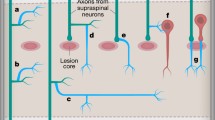Conclusion
We intended to demonstrate that spinal cord injury should not be regarded anymore as a hopeless inevitability. There are many research axes. Obstacle to regrowth exists on the biological plane. Ideological barrier also exists among men. The various factors involved in the posttraumatic lesional mechanisms and the different research paths on repair confirm the scale of the issue. It can be solved at the level of one mechanism among others and any physician confronted with this possibility of axonal regrowth should bear in mind the whole range of related phenomena. However, we can only envisage the future by sharing the results, with a global approach of the issues in order to achieve the expected regrowth in the best possible conditions. Fundamental research is indispensable and constitutes the basis for any progress. Clinical research in human beings should logically take over. It must be repeated that everything is settled at a very early stage and surgical decompression as well as recalibration should be therefore considered as an emergency. It concerns all researchers, surgeons, physical therapists, without overlooking the main figure, i.e. the cord injured patient. In this day and age when all the information is available on the internet, there are too many false hopes raised by a delusive article, far too many abuses committed to the detriment of patients for venal purposes. It is up to us to create cohesion, to share our impressions, our certainties but also our misgivings. There is still a long way to go, however at the beginning of this 21st century, optimism should be our guide.
Similar content being viewed by others
References
RAMON Y CAJAL S.R.: ESTUDIOS SOBRE LA DEGENERACION Y REGENERACION DEL SISTEMO NERVIOSO, MADRID. MOYA ED. 1913
AGUAYO A. J.: AXONAL REGENERATION FROM INJURED NEURONS IN THE ADULT MAMMALIAN CENTRAL NERVOUS SYSTEM. SYNAPTIC PLASTICITY. NEW YORK. COTMAN ED. 457–484, 1985
DIM1TRIJEVIC M.R., GERASIMENKO Y., PINTER M.M.: EVIDENCE FOR A SPINAL CENTRAL GENERATOR IN HUMANS ANN. NEW YORK ACAD SCI., 860: 360–376. 1998
PRIVAT A.: PHYSIOPATHOLOGIE DU TRAUMATISME MÉDULLAIRE ET CONSÉQUENCES THÉRAPEUTIQUES. BULL. ACAD. NOATLE. MÉD. 189, 6: 1109–1118, 2005
BONNY J. M., GAVIARA M., DONNAT JP AND AL: NUCLEAR MAGNETIC RESONANCE MICRO-IMAGING OF MOUSE SPINAL CORD IN VIVO. NEUROBIOL DIS, 15:474–482, 2004
TADIE M., GAVIARA M AND AL: EARLY CARE AND TREATMENT WITH A NEUROPROTECTIVE DRUG, GACYCLIDINE, IN PATIENTS WITH ACUTE SPINAL CORD INJURY. RACHIS. 15: 363–376. 2003
REIER PJ., ENG L.F., JAKEMAN L: REACTIVE ASTROCYTE AND AXONAL OUTGROWTH IN THE INJURED CNS: IS GLIOSIS REALLY AN IMPEDIMENT TO REGENERATION? NEURAL REGENERATION AND TRANSPLANTATION FRONTIERS OF CUNICALNEUROSCIENCE. SEIL F. J. ED. VOL 6: 183–209. ALAN R. LISS. NEW YORK. 1989
GIMENEZ Y RIBOTTA M., RAJAOFETRA N. AND AL: OXYSTEROLPROMOTES SEROTONERGIC REINNERVATION IN THE LESIONED RAT SPINAL CORD BY REDUCING GLIAL REACTION. J. NEUROSCI. RES., 41:79–95, 1995
GIMENEZ Y RIBOTTA M., GAVARIA M. AND AL: STRATEGIES FOR REGENERATION AND REPAIR IN SPINAL CORD TRAUMATIC INJURY, PROGRESS IN BRAIN RESEARCH. 137. 2002
BUSH T.G., PUVANACHANDRA N. AND AL: LEUCOCYTES INFILTRATION, NEURONAL DEGENERATION AND NEURITE OUTGROWTH AFTER ABLATION OF SCARFORMING REACTIVE ASTROCYTES IN ADULT TRANSGENIC MICE. NEURON 23: 297–308. 1999
MENET V., GIMENEZ Y RIBOTTA M., AND AL: INACTIVATION OF GLIAL FIBRILLARY ACIDIC PROTEIN GENE, BUT NOT OF VIMENTIN, IMPROVES NEURONAL SURVIVAL AND NEURITE GROWTH BY MODIFYING ADHESION MOLECULE EXPRESSION. J. NEUROSCI. 21: 6147–6158, 2001
PRIVAT A., MANSOUR H., PAVY H.: TRANSPLANTATION OF FETAL SEROTONINE NEURONS INTO THE TRANSECTED SPINAL CORD OF ADULT RATS. NEUROSCI. LETT. 66: 61–66. 1986
RAISMAN G.: REPAIR OF SPINAL CORD INJURY BY TRANSPLANTATION OF OLFACTORY ENSHEATING CELLS CR BOIL, 330(6–7):557–60, 2007
Additional information
I express my gratitude to Dr Alain PRIVAT, who provided valuable advice for the writing of this article and whose works are an honour to French research.
Rights and permissions
About this article
Cite this article
Robert, R., Perrouin-Verbe, B. & Hamel, O. Possibilities of regeneration after spinal cord injury or severing. ArgoSpine News J. 16, 10–16 (2007). https://doi.org/10.1007/BF03041122
Issue Date:
DOI: https://doi.org/10.1007/BF03041122




